Deep Impact Tour in Hawaii
As we approached the summit, we felt as if we
had been driving on the surface of the Mars.
One of the holiest places in this world.
The Giant Telescopes are there to unveil the secret of the Universe.
July 2005
Visiting Subaru Telescope
Subaru Telescope
http://www.subarutelescope.org/index.html
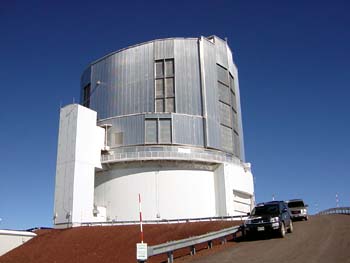

Subaru Dome Subaru
Dome with a sea of cloud for a background

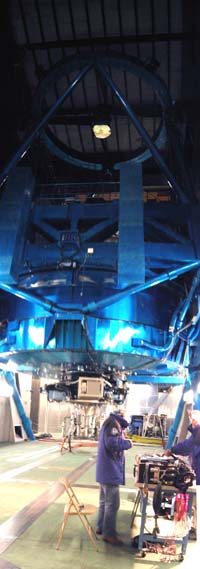
The bottom of the Telescope: Cassegrain focus with Cooled Mid
Infrared Camera and Spectrometer (COMICS)
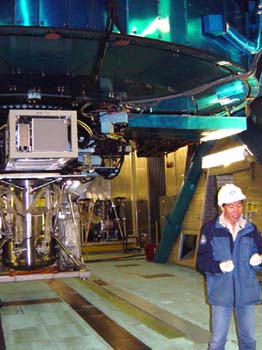

An astronomer guided us. Coronagraphic
Imager with Adaptive Optics (CIAO)
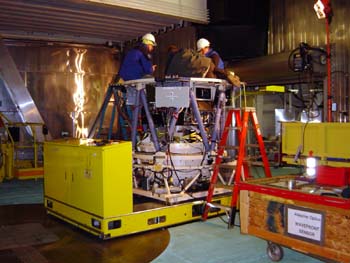

Faint
Object Camera And Spectrograph (FOCAS) Primary Mirror "CO2
Cleaning" system
Other Telescopes
Please refer to
Summit map
http://www.ifa.hawaii.edu/ifa/maps/summit_map.htm
Mauna Kea Telescopes
http://www.ifa.hawaii.edu/mko/telescope_table.htm
http://www.ifa.hawaii.edu/mko/maunakea.htm
Aerial Tour of the Mauna Kea Observatories
http://www.ifa.hawaii.edu/images/aerial-tour/aerial-tour.html

From left to right: Keck II and
Keck I, Subaru building, Subaru.
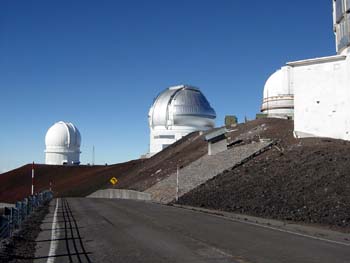
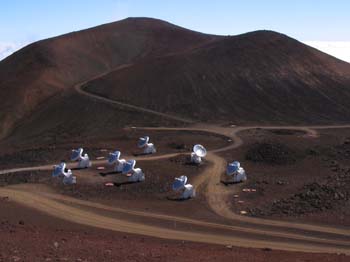
Left: From left to right: Canada-France-Hawaii Telescope (CFHT),
Gemini, University of Hawaii 2.2 m,
United Kingdom Infra Red (UKIR,
only the wall is seen)
Right: Submillimeter Array
(SAMA)

From left to right: (in the valley) Caltech Submillimeter Observatory
(CSO), James Clerk Maxwell
Telescope (JCMT), Submillimeter Array (SAMA), (sky line) Subaru, Keck
I, Keck II, NASA Infrared Telescope Facility (IRTF, silver) and S. Murakami.
Deep Impact Observation
In the evening of Saturday, July 2 (Hawaii Time), we enjoyed star watching
at the Visitor Information Station (VIS) at the Onizuka Center for International
Astronomy (OCIA), 9200 ft (2800 m). Many vehicles came in and went out there
probably due to weekend, and the light of them were annoying.
The next day, the day of Impact, Sunday July 3, we went up to the parking
lot of 1170 feet (3500 m). One reason was that it was drizzling at VIS and
might not recover. Another was that VIS would be crowded with so many visitors.
There came some vehicles with astronomers at the parking lot but it was
much calmer than the previous day. A family who parked next to us was an
professional astronomer in Gemini Telescope. He brought a Dobsonian telescope
(some 8”) and he said he made it in his 16.
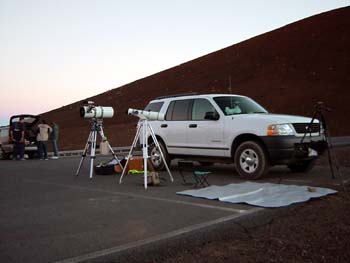
The parking lot of 1170 feet (3500 m) and our vehicle. We used 8” reflector
(left, Vixen R200SS) and 5” refractor (right, BORG 125ED)
I had prepared for a star atlas to make the measurement of the comet brightness,
however, as I did not intend to do so strongly before I left Japan. Instead,
I wanted to spend time to enjoy star watching including Deep Impact.
The outline and the impression of Deep Impact Observation
Telescope: 8” reflector, 31x, 77x
2005 Jul 03.26-03.35 UT (Jul 2, 8:20pm-10:30pm Hawaii time)
The end of twilight: 8:30pm
Site: VIS at OCIA, Mauna Kea, 9200 ft (2800 m).
Naked eye limiting magnitude: 7.8
I observed the comet a few times during the observing session. DC=4
2005 Jul 04.24-04.35 UT (Jul 3, 7:45pm-10:20pm, Hawaii Time)
The end of twilight: 8:30pm
Site: parking lot of 1170 feet (3500 m)
Naked eye limiting magnitude: 7.5
I observed the comet several times during the observing session. DC=6,
m1 looked brighter at most 0.5 magnitude than that of the previous day.
General Observation
I could recognize spiral structure of M51, M101 and M83 with direct vision
using 8” telescope. Those could be seen with averted vision under excellent
transparency at my observing site in Japan.
I could observe neither the Snake Nebula in Ophiuchus (S-shaped dark line,
Barnard 72) nor NGC 6822 in Sagittarius (an irregular member of our Local
Galaxy Group and 2.2 million light years distance, 19’x15’) even with my
18” Dobsonian in my country. They were easily seen with 8” at Mauna Kea.
Generally, deep sky object images observed by 8” reflector in Mauna Kea
were a little inferior to those of 18” at my usual observing site in Japan.
As experienced, very faint objects, like Barnard 72 and NGC 6822, are not
expected to be observed in Japan even if you employ large instruments.
Scintillation was very stable in Mauna Kea. After sunset I trained 5” refractor
on Venus and Mercury. I could see apparent scintillation that caused by
convection from heated ground surface. However, after the end of the twilight
it was extremely stable. The image of Jupiter was very steady with 5” refractor
with 200x and 343x.
About the roads to the summit
Please refer to the Big Island (Hawaii Island) map
http://www.ifa.hawaii.edu/ifa/maps/big_isle_map2.htm
We stayed in Kailua Kona and headed for Mauna Kea via Route 190, Route 200 (Sddle
Road), Mauna Kea Observatories Access Road and John. A. Burns Way.
Route 190 is a usual road, but Route 200 is partly rough: a rental car
is prohibited to drive this road except that of Harper Car and Truck Rental.
I felt if you drive with care using Harper’s car it is no problem. Note
that SLI (Supplemental Liability Insurance) is not offered at all by Harper.
To VIS you can drive with usual car but only 4WD car is permitted to dive
up to the summit via John. A. Burns Way.
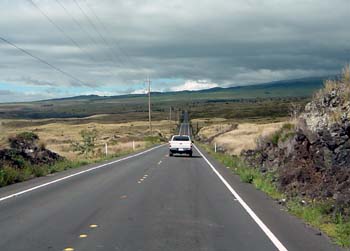

Left: Route 190
Right: Route 200, the shoulder is rough and some drive at
the center to avoid this: it causes a head-on collision.
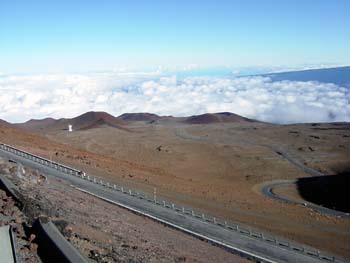
Road near the summit (John. A. Burns Way). The road is paved near the summit,
but halfway up to the VIS is dirt road.
Sight seeing


Route 11, to Volcano via lava flats. Entrance of
the Lava Tube formed by volcanic activities at Volcano.

Halemaumau: a volcanic crater with diameter of 3000 ft (900 m).


Beach in front of the hotel in Kailua Kona Independence
Day parade
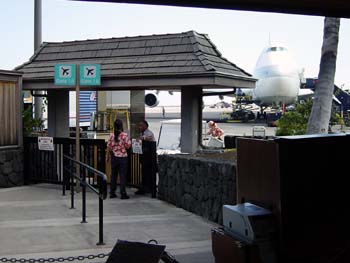
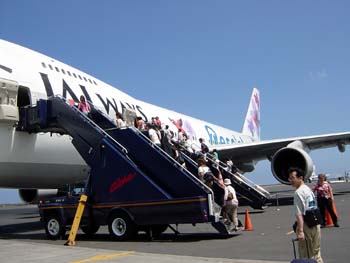
Boarding Gate at Kona Air Port Boarding






















